Cooler Master MasterAir MA824 Stealth CPU Cooler Review
Massive air coolers may get in the way of things like DIMM slot access, but the localized placement of their cooling fans offers benefits that are rarely seen in the alternative. There’s also no pump to make noise or break down and no liquid coolant to leak all over everything. The right designer can even come up with ways to make clearance for nearby parts: Notice from Cooler Master’s illustration that its designer shortened the MasterAir MA824 Stealth’s lower front fins to 67mm to make room for tall memory.
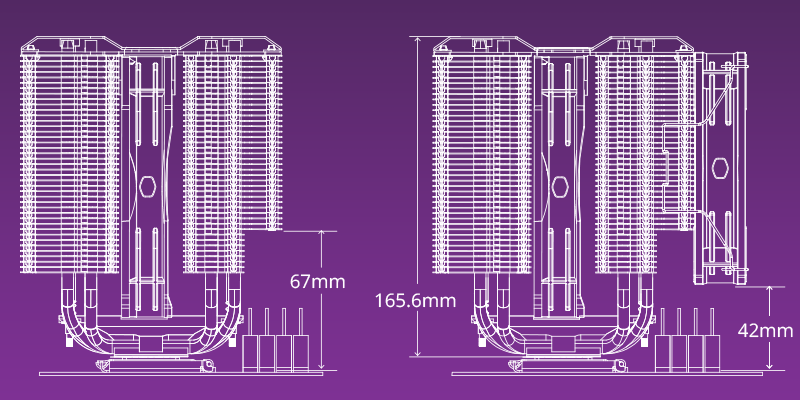
With its eight heat pipes connecting two large fans via two heat sinks, the MA824 Stealth’s giant proportions leave little doubt about the designer’s intent or the hardware’s capability, though we’ll still have to verify the later through our below test methods. Our observed measurements differ slightly from manufacturer spec in that Cooler Master didn’t include the amount by which the front fan’s clips stick out from the sides of the front cooling tower.
| Cooler Master MasterAir MA824 Stealth (MAM-D8PN-318PK-R1) | |||
| Type | Cross Draft Dual Tower | Offsets | 26mm forward w/front fan |
| CPU Support | LGA 1700/1200/115x, AM5/4 | Fan Size | (1) 135mm + (1) 120mm x 27mm |
| Height/Width/Depth | 166mm / 155mm / 162mm | Connectors | (2) PWM (includes y-cable) |
| Base Height | 44mm | Weight | 1490g (53oz) w/Intel kit |
| Warranty | 5-Years | Web Price | $130 |
Get it at Amazon

(click for availability)
The above drawing probably made it clear that builders have the option of using either tall memory or the front fan when installing Cooler Master’s MasterAir MA824 Stealth, but it’s probably a little less clear that simply moving the front fans clips up the sides of the cooler by a couple fins will give it enough clearance to fit over 44mm DIMMs such as G.Skill’s Trident Z5 6800 or Patriot’s Viper Venom RGB 6200: Given the 44mm side clearance and inclusion of both AMD (below, center) and Intel (below, right) installation kits, the MA824 Stealth fits every platform we’ve tested for the past two years despite its enormity. Cooler Master even includes a #2 Philips screwdriver (ground onto the tip of a hex key) and splitter cable to aid installation.
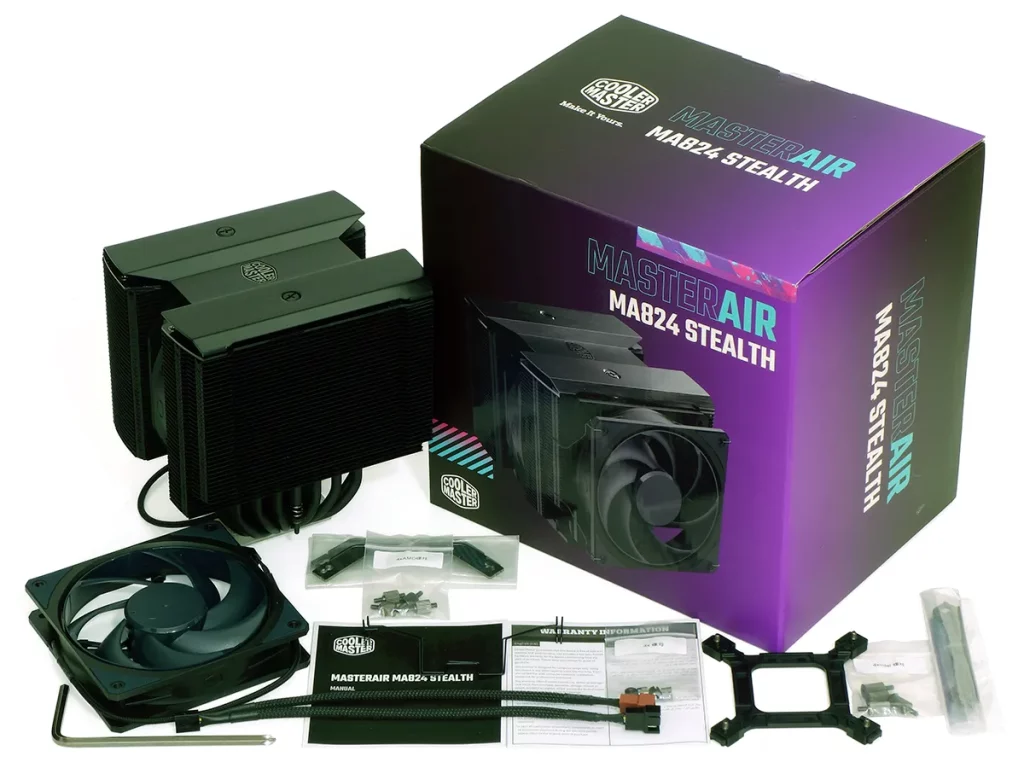
Underneath we found the bottom of a special 135mm fan with 120mm frame spacing, shorter fins near the base that increase front memory clearance to 67mm, E-clips that secure extra-long spring screws to the upper mounting bracket, and factory-applied thermal compound over a base that appears to have been cut using a lathe and polished…without flattening. See the shiny concentric ring pattern that looks like ripples in a pond.
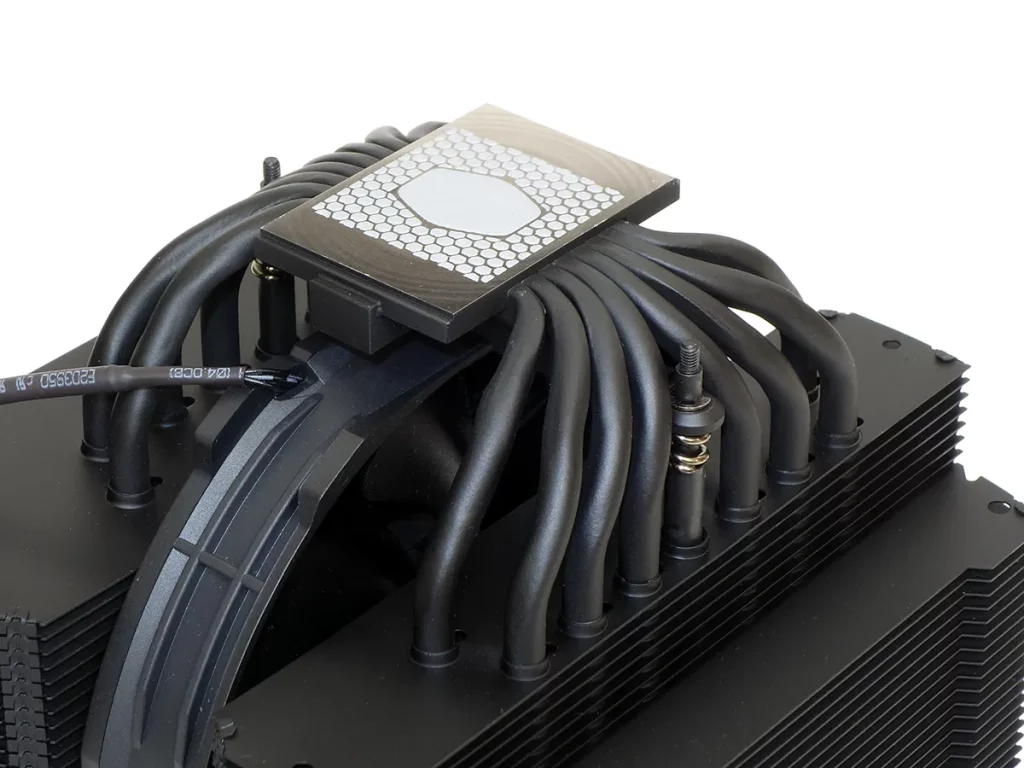
Most users won’t need to disassemble their MA824 Stealth until its five-year-warranty center fan wears out, but we didn’t feel so bad about pulling ours apart since it arrived with its top pieces a bit loose. Plastic pins (see enlargement) are pushed into drilled holes of the aluminum cover’s underside, and another set of plastic pins faces the opposite direction to engage holes that are drilled into the outer corners of heat sink fins. A set of four small screws further secure that plastic piece to the inner corners of the heat sinks.
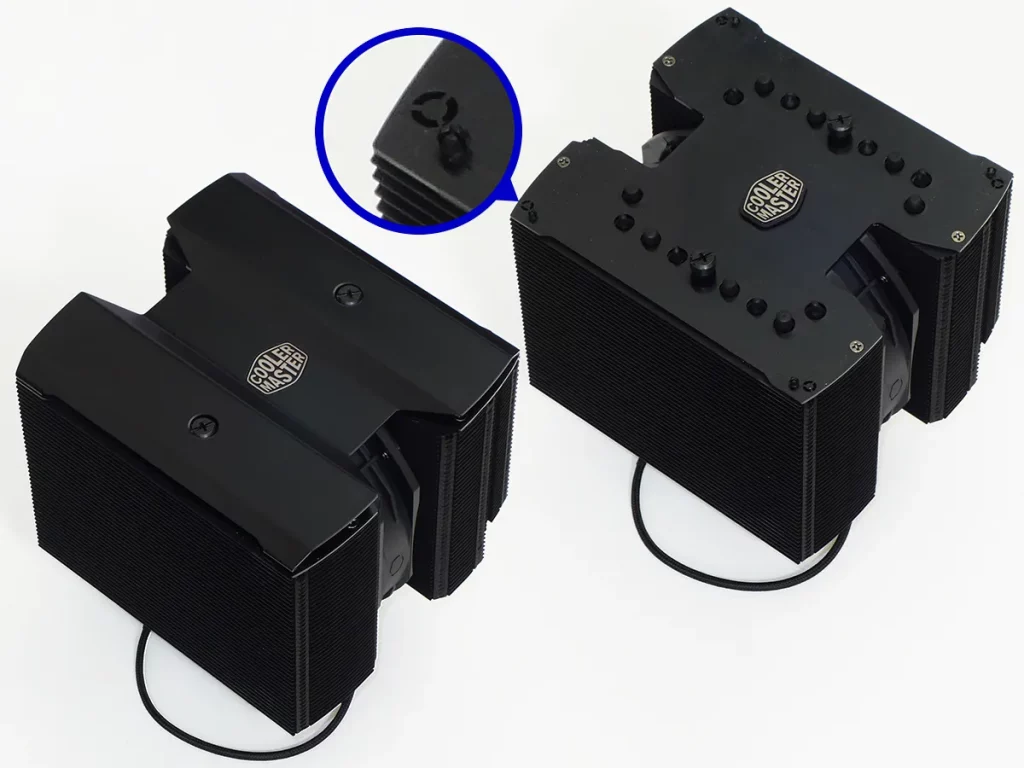
This is where the E-clips mentioned two photos ago come into play: The MA824 Stealth’s two spring screws must also be removed before the plastic piece mentioned one photo ago can be removed.
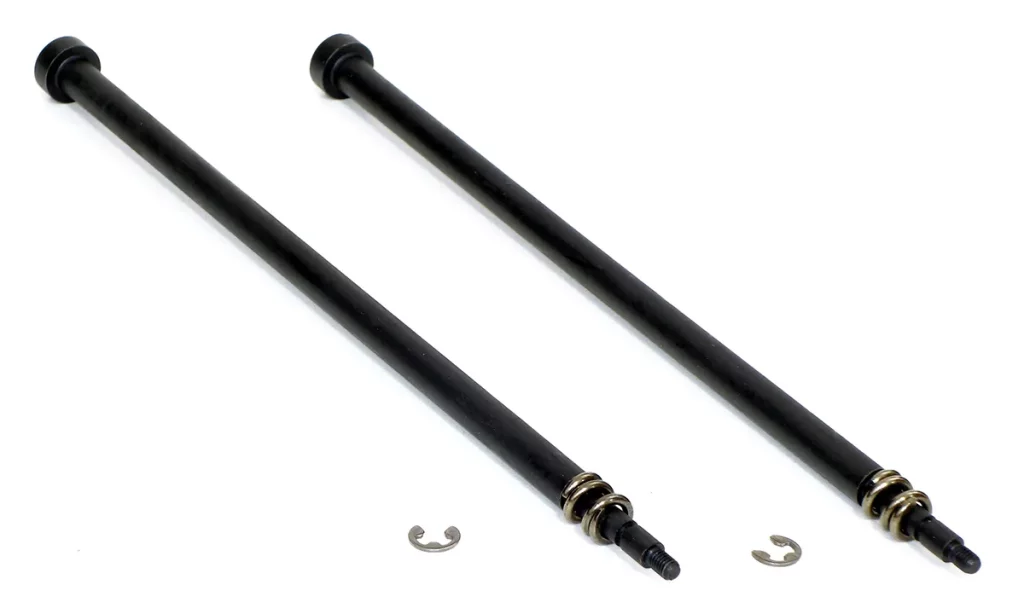
With the four inner-corner sheet metal screws and two large spring screws removed, the plastic piece can now be ripped from the heat sink: Its barbs so firmly caught the outer corners our sample’s top fins that they broke free from the assembly at two points, requiring us to employ basic sheet metal forming skills to make the unit appear photogenic again.

The only reason to pull the MA824 Stealth apart that far is to gain access to its center fan, which we will again state that most users are unlikely to do for quite some time. But doing this did give us a good photo of the 135mm fan’s uniquely designed frame, as well as allowing us to confirm that the screw spacing of its fan holder is an accurate match for ordinary 120mm replacements.
Installing the MasterAir MA824 Stealth
MA824 Stealth installation begins with standoffs, which screw into either the motherboard’s factory support bracket (AMD AM5, AM4, etc) or the Cooler Master supplied support plate (LGA1700/1200/115x). Cross brackets then top the standoffs, and a set of nuts hold the cross brackets to the standoffs. Cross cuts on the nuts allow these to be turned using a #2 Phillips screwdriver.
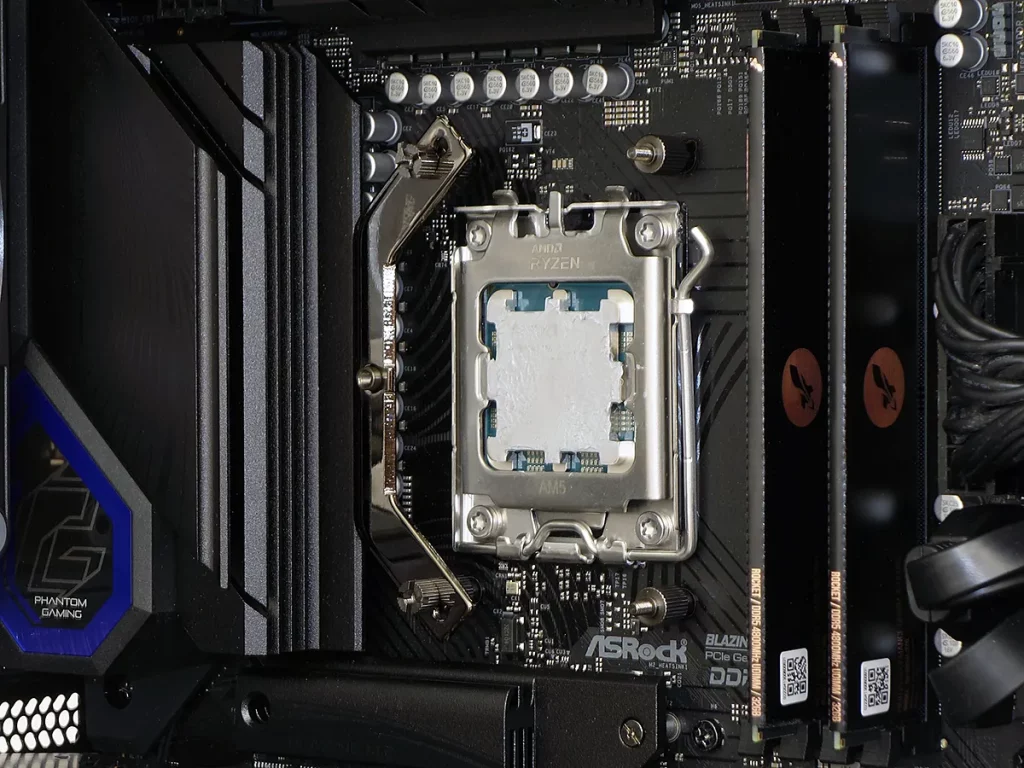
We found that getting the spring screws to align with corresponding holes on the cross brackets was the most difficult installation step: No matter how hard we tried, we kept hitting the outer part of the raised lip that surrounded the hole until suddenly, after a few minutes of trying, we accidently struck a mounting hole. Turning the screw a couple time allowed us to use that side as a pivot point to aid finding the opposite hole, whereupon we finished tightening each side by alternating a couple turns at a time.
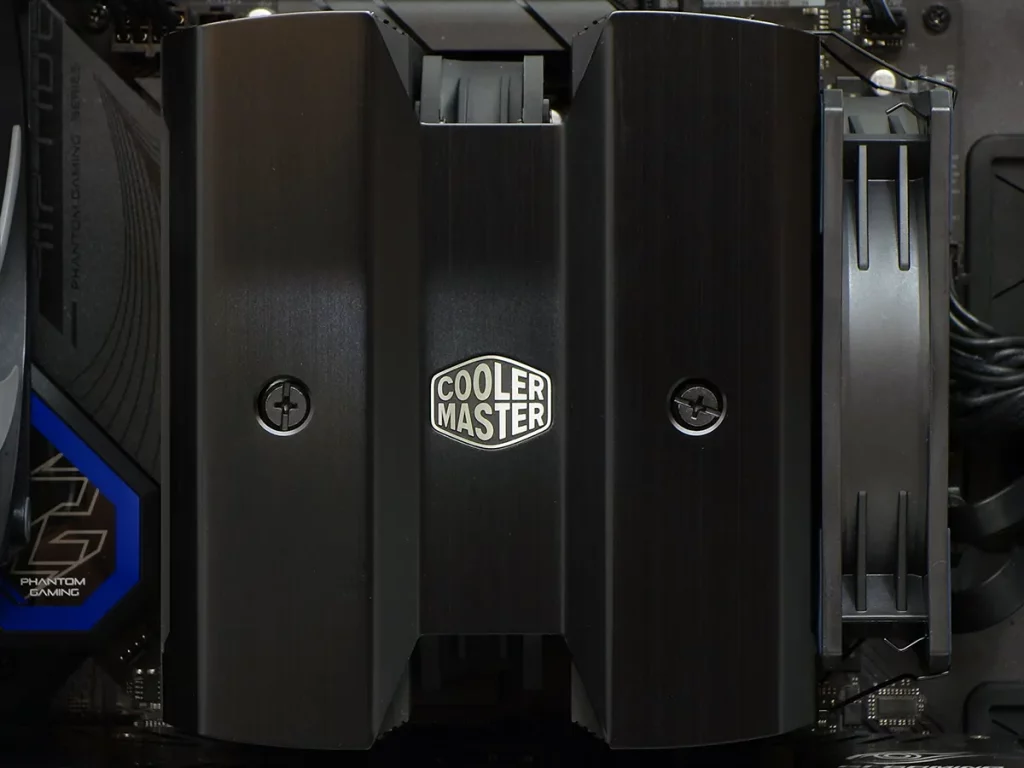
This is how the MA824 Stealth appears in our finished build…
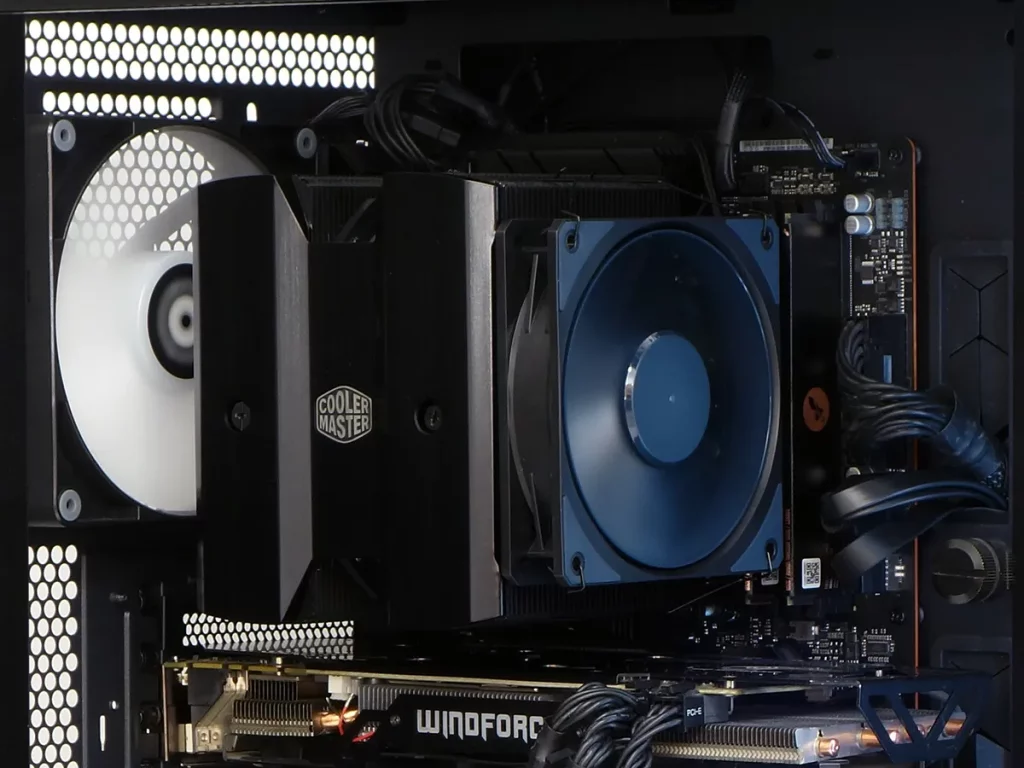
…and these are the parts we’re stressing:
| System Configuration | |
| Case | Thermaltake Ceres 500 TG ARGB |
| CPU | AMD Ryzen 9 7900X: 12 cores/ 24 threads, 64MB L3 Cache O/C to 5.00 GHz at 1.25 V Core |
| Motherboard | ASRock B650E PG Riptide WiFi, BIOS 1.18 |
| RAM | Sabrent Rocket SB-DR5U-32GX2 64GB DDR5-4800 |
| System Drive | HP SSD FX900 M.2 1TB NVMe SSD |
Test Results
The MA824 Stealth allows our clock-locked and voltage-locked processor to run just a little cooler on average than its closed-loop liquid cousin, the MasterLiquid 240L. Yet while we’d love to call that a victory for air, the two other closed-loop coolers edge out both Cooler Master products.

We configure our closed-loop radiators to pull air over our motherboard’s voltage regulator, but that cooling method isn’t as effective as blowing into its heat sinks. This is an area where most local heat sink and fan combos will beat most remote radiator systems, no matter how well that radiator is placed.
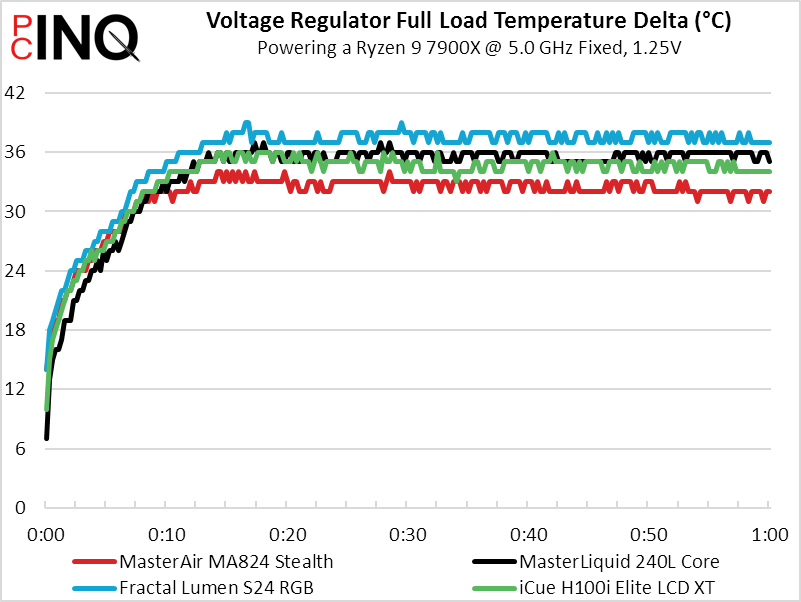
We were exceedingly pleased with the MA824 Stealth’s low noise level even before we turned on our meter to see just how much quieter it was compared to everything else this newish test platform had held.
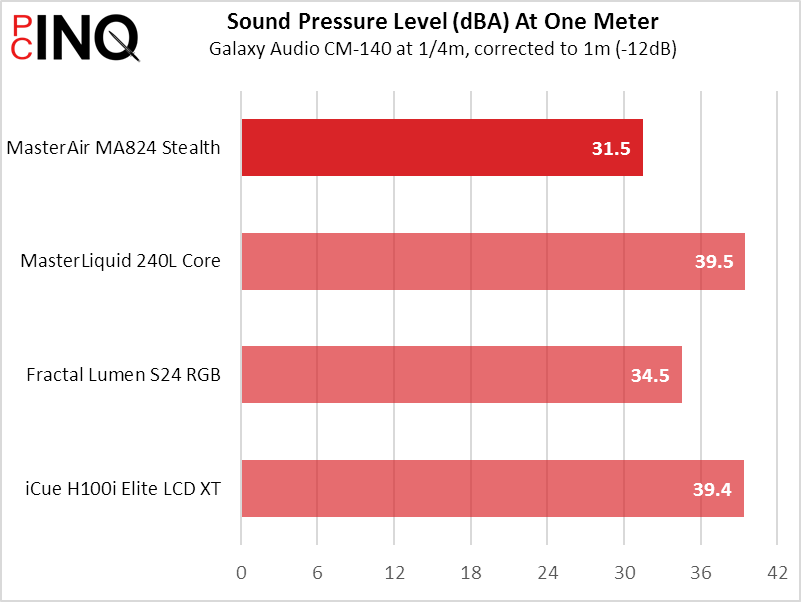
Even with noise differences being undervalued (by treating the SPL scale as linear rather than logarithmic), the MA824 Stealth still has a vastly superior cooling to noise ratio compared to competitors that were only slightly cooler (in CPU temperature) but far noisier. And it looks even better in VR MOS cooling performance, since it’s the coolest as well as the quietest in that comparison.
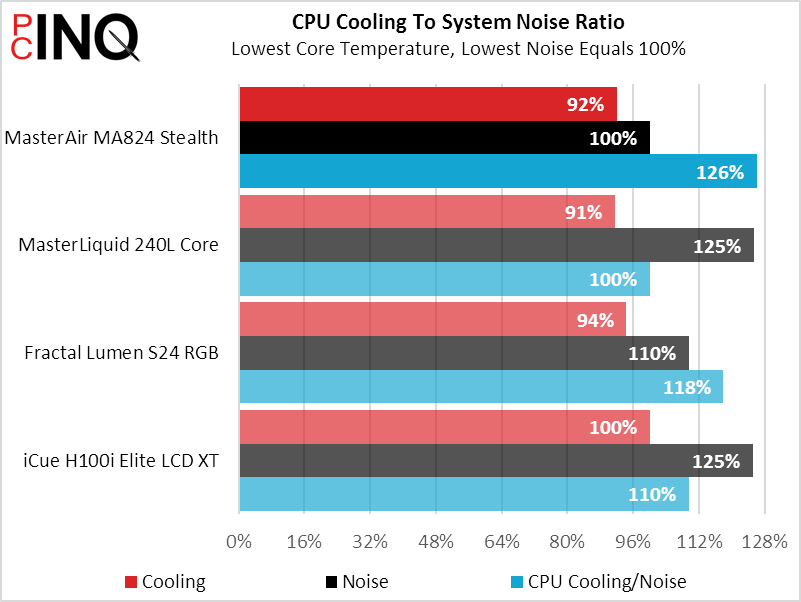
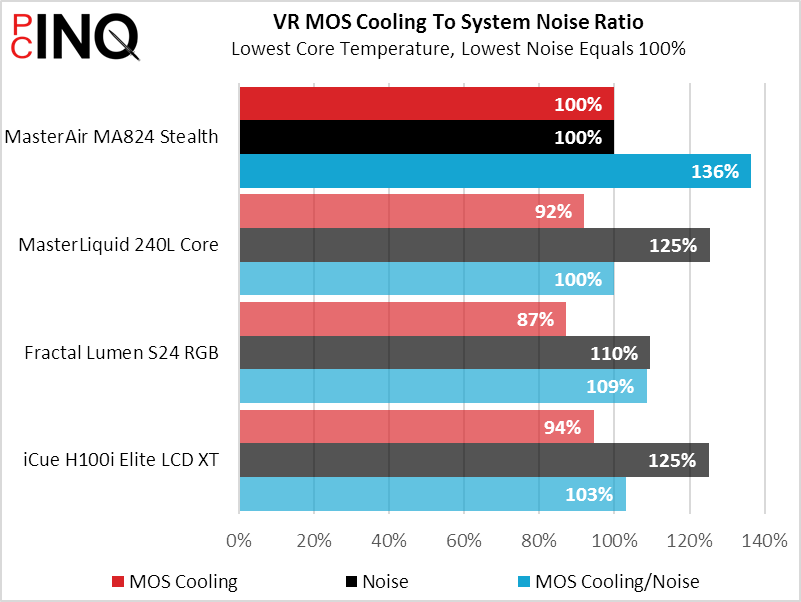
We’ve already seen other headlines that claim the MA824 Stealth as one of the best performing CPU air coolers that’s ever reached the market, and indeed our temperature and noise results indicate that this may be possible. It was certainly much quieter than the two similarly-sized closed-loop radiator systems that edged it out in cooling, and it even beat Cooler Master’s own “240mm” closed-loop part in both metrics. Unfortunately, we don’t have recent air coolers of this scale to compare. Without other air coolers of this size to compare, we have only proved that the MA824 Stealth provides slightly less cooling at far less noise than some of our similarly-priced closed-loop radiator systems.
| Cooler Master MasterAir MA824 Stealth (MAM-D8PN-318PK-R1) | |
| Pros: | Cons: |
| Best cooling to noise ratio | High MSRP meets limited US availability |
| The Verdict: | |
| Nearly as cool as our similarly sized closed loop coolers, the MasterAir MA824 Stealth beats those in both quietness and cooling-to-noise ratio. | |
Get it at Amazon

(click for availability)
